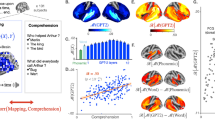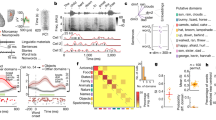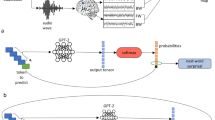Abstract
The N400 component of the event-related brain potential has aroused much interest because it is thought to provide an online measure of meaning processing in the brain. However, the underlying process remains incompletely understood and actively debated. Here we present a computationally explicit account of this process and the emerging representation of sentence meaning. We simulate N400 amplitudes as the change induced by an incoming stimulus in an implicit and probabilistic representation of meaning captured by the hidden unit activation pattern in a neural network model of sentence comprehension, and we propose that the process underlying the N400 also drives implicit learning in the network. The model provides a unified account of 16 distinct findings from the N400 literature and connects human language comprehension with recent deep learning approaches to language processing.
This is a preview of subscription content, access via your institution
Access options
Access Nature and 54 other Nature Portfolio journals
Get Nature+, our best-value online-access subscription
9,800 Yen / 30 days
cancel any time
Subscribe to this journal
Receive 12 digital issues and online access to articles
¥14,900 per year
only ¥1,242 per issue
Buy this article
- Purchase on SpringerLink
- Instant access to full article PDF
Prices may be subject to local taxes which are calculated during checkout







Similar content being viewed by others
References
Kutas, M. & Hillyard, S. A. Reading senseless sentences: brain potentials reflect semantic incongruity. Science 207, 203–205 (1980).
Kutas, M. & Federmeier, K. D. Thirty years and counting: finding meaning in the N400 component of the event-related brain potential (ERP). Annu. Rev. Psychol. 62, 621–647 (2011).
Lau, E. F., Phillips, C. & Poeppel, D. A cortical network for semantics: (de)constructing the N400. Nat. Rev. Neurosci. 9, 920–933 (2008).
Debruille, J. B. The N400 potential could index a semantic inhibition. Brain Res. Rev. 56, 472–477 (2007).
Federmeier, K. D. & Laszlo, S. in The Psychology of Learning and Motivation–Advances in Research and Theory Vol. 51, 1–44 (2009).
Baggio, G. & Hagoort, P. The balance between memory and unification in semantics: a dynamic account of the N400. Lang. Cogn. Process. 26, 1338–1367 (2011).
Brown, C. & Hagoort, P. The processing nature of the N400: evidence from masked priming. J. Cogn. Neurosci. 5, 34–44 (1993).
Chomsky, N. Syntactic Structures (Mouton, 1957).
Fodor, J. Modularity of Mind (MIT Press, 1981).
Fodor, J. & Pylyshyn, Z. W. Connectionism and cognitive architecture: a critical analysis. Cognition 28, 3–71 (1988).
Jackendoff, R. Foundations of Language: Brain, Meaning, Grammar, Evolution (Oxford Univ. Press, Oxford, 2002).
McClelland, J. L., St. John, M. F. & Taraban, R. Sentence comprehension: a parallel distributed processing approach. Lang. Cogn. Process. 4, 287–336 (1989).
St John, M. F. & McClelland, J. L. Learning and applying contextual constraints in sentence comprehension. Artif. Intell. 46, 217–257 (1990).
Laszlo, S. & Plaut, D. C. A neurally plausible Parallel Distributed Processing model of Event-Related Potential word reading data. Brain Lang. 120, 271–281 (2012).
Laszlo, S. & Armstrong, B. C. PSPs and ERPs: applying the dynamics of post-synaptic potentials to individual units in simulation of temporally extended Event-Related Potential reading data. Brain Lang. 132, 22–27 (2014).
Cheyette, S. J. & Plaut, D. C. Modeling the N400 ERP component as transient semantic over-activation within a neural network model of word comprehension. Cognition 162, 153–166 (2017).
Itti, L. & Baldi, P. Bayesian surprise attracts human attention. Vis. Res. 49, 1295–1306 (2009).
Griffiths, T. L., Stevyers, M. & Tenenbaum, J. B. Topics in semantic representation. Psychol. Rev. 114, 211–244 (2007).
Andrews, M., Vigliocco, G. & Vinson, D. Integrating experiential and distributional data to learn semantic representations. Psychol. Rev. 116, 463–498 (2009).
Wu, Y. et al. Google’s neural machine translation system: bridging the gap between human and machine translation. Preprint at https://arxiv.org/abs/1609.08144 (2016).
Seidenberg, M. S. & McClelland, J. L. A distributed, developmental model of word recognition and naming. Psychol. Rev. 96, 523–568 (1989).
McClelland, J. L. in The Handbook of Language Emergence (eds. MacWhinney, B. & O’Grady, W.) 54–80 (Wiley, New York, NY, 2015).
Barsalou, L. W. Grounded cognition. Annu. Rev. Psychol. 59, 617–645 (2008).
Pulvermüller, F. Words in the brain’s language. Behav. Brain Sci. 22, 253–336 (1999).
Kutas, M. & Hillyard, S. A. Brain potentials during reading reflect word expectancy and semantic association. Nature 307, 101–103 (1984).
Van Petten, C. & Kutas, M. Influences of semantic and syntactic context on open- and closed-class words. Mem. Cogn. 19, 95–112 (1991).
Levy, R. Expectation-based syntactic comprehension. Cognition 106, 1126–1177 (2008).
Frank, S. L., Galli, G. & Vigliocco, G. The ERP response to the amount of information conveyed by words in sentences. Brain Lang. 140, 1–25 (2015).
Federmeier, K. D. & Kutas, M. A rose by any other name: long-term memory structure and sentence processing. J. Mem. Lang. 41, 469–495 (1999).
Hagoort, P., Baggio, G. & Willems, R. M. in The Cognitive Neurosciences (ed. Gazzaniga, M. S.) 819–836 (MIT, Cambridge, MA, 2009).
Barber, H., Vergara, M. & Carreiras, M. Syllable-frequency effects in visual word recognition: evidence from ERPs. Neuroreport 15, 545–548 (2004).
Koivisto, M. & Revonsuo, A. Cognitive representations underlying the N400 priming effect. Cogn. Brain Res. 12, 487–490 (2001).
Rugg, M. D. The effects of semantic priming and word repetition on event-related potentials. Psychophysiology 22, 642–647 (1985).
Kuperberg, G. R., Sitnikova, T., Caplan, D. & Holcomb, P. J. Electrophysiological distinctions in processing conceptual relationships within simple sentences. Cogn. Brain Res. 17, 117–129 (2003).
Kim, A. & Osterhout, L. The independence of combinatory semantic processing: evidence from event-related potentials. J. Mem. Lang. 52, 205–225 (2005).
Brouwer, H., Crocker, M. W., Venhuizen, N. J. & Hoeks, J. C. J. A neurocomputational model of the N400 and the P600 in language processing. Cogn. Sci. 41, 1318–1352 (2017).
Van Herten, M., Kolk, H. H. J. & Chwilla, D. J. An ERP study of P600 effects elicited by semantic anomalies. Cogn. Brain Res. 22, 241–255 (2005).
Hagoort, P. & Brown, C. M. ERP effects of listening to speech compared to reading: the P600 / SPS to syntactic violations in spoken sentences and rapid serial visual presentation. Neuropsychologia 38, 1531–1549 (2000).
Federmeier, K. D., Wlotko, E. W., De Ochoa-Dewald, E. & Kutas, M. Multiple effects of sentential constraint on word processing. Brain Res. 1146, 75–84 (2007).
Friedrich, M. & Friederici, A. D. N400-like semantic incongruity effect in 19-month-olds: processing known words in picture contexts. J. Cogn. Neurosci. 16, 1465–1477 (2004).
Atchley, R. A. et al. A comparison of semantic and syntactic event related potentials generated by children and adults. Brain Lang. 99, 236–246 (2006).
Kutas, M. & Iragui, V. The N400 in a semantic categorization task across 6 decades. Electroencephalogr. Clin. Neurophysiol. 108, 456–471 (1998).
Gotts, S. J. Incremental learning of perceptual and conceptual representations and the puzzle of neural repetition suppression. Psychon. Bull. Rev. 23, 1055–1071 (2016).
McLaughlin, J., Osterhout, L. & Kim, A. Neural correlates of second-language word learning: minimal instruction produces rapid change. Nat. Neurosci. 7, 703–704 (2004).
Schultz, W., Dayan, P. & Montague, P. R. A neural substrate of prediction and reward. Science 275, 1593–1599 (1997).
Friston, K. A theory of cortical responses. Phil. Trans. R. Soc. Lond. 360, 815–836 (2005).
McClelland, J. L. in International Perspectives on Psychological Science (eds Bertelson, P, Eelen, P. & d’Ydewalle, G.) Vol. 1, 57–88 (Lawrence Erlbaum Associates, Hillsdale, 1994).
Besson, M., Kutas, M. & Van Petten, C. An Event-Related Potential (ERP) analysis of semantic congruity and repetition effects in sentences. J. Cogn. Neurosci. 4, 132–149 (1992).
Rabovsky, M. & McRae, K. Simulating the N400 ERP component as semantic network error: insights from a feature-based connectionist attractor model of word meaning. Cognition 132, 68–89 (2014).
Kuperberg, G. R. Separate streams or probabilistic inference? What the N400 can tell us about the comprehension of events. Lang. Cogn. Neurosci. 31, 602–616 (2016).
Schott, B., Richardson-Klavehn, A., Heinze, H.-J. & Düzel, E. Perceptual priming versus explicit memory: dissociable neural correlates at encoding. J. Cogn. Neurosci. 14, 578–592 (2002).
Rumelhart, D. E. in Metaphor and Thought (ed. Ortony, A.) 71–82 (Cambridge Univ. Press, Cambridge, UK, 1979).
McCarthy, G., Nobre, A. C., Bentin, S. & Spencer, D. D. Language-related field potentials in the anterior–medial temporal lobe: I. Intracranial distribution and neural generators. J. Neurosci. 15, 1080–1089 (1995).
Nobre, A. C. & McCarthy, G. Language-related field potentials in the anterior–medial temporal lobe: II. Effects of word type and semantic priming. J. Neurosci. 15, 1090–1098 (1995).
Sanford, A. J. & Sturt, P. Depth of processing in language comprehension: not noticing the evidence. Trends Cogn. Sci. 6, 382–386 (2002).
Ferreira, F., Bailey, K. G. D. & Ferraro, V. Good-enough representations in language comprehension. Curr. Dir. Psychol. Sci. 11, 11–15 (2002).
Dronkers, N. F. et al. Lesion analysis of the brain areas involved in language comprehension. Cognition 92, 145–177 (2004).
Turken, A. U. & Dronkers, N. F. The neural architecture of the language comprehension network: converging evidence from lesion and connectivity analyses. Front. Syst. Neurosci. 5, 1–20 (2011).
Bookheimer, S. Functional MRI of language: new approaches to understanding the cortical organization of semantic processing. Annu. Rev. Neurosci. 25, 151–188 (2002).
Friederici, A. D. Towards a neural basis of auditory sentence processing. Trends Cogn. Sci. 6, 78–84 (2002).
Thompson-Schill, S. L., D’Esposito, M., Aguirre, G. K. & Farah, M. J. Role of left inferior prefrontal cortex in retrieval of semantic knowledge: a reevaluation. Proc. Natl Acad. Sci. USA 94, 14792–14797 (1997).
Clayards, M., Tanenhaus, M. K., Aslin, R. N. & Jacobs, R. A. Perception of speech reflects optimal use of probabilistic speech cues. Cognition 108, 804–809 (2008).
Van Petten, C., Coulson, S., Rubin, S., Plante, E. & Parks, M. Time course of word identification and semantic integration in spoken language. J. Exp. Psychol. Learn. Mem. Cogn. 25, 394–417 (1999).
van den Brink, D., Brown, C. M. & Hagoort, P. The cascaded nature of lexical selection and integration in auditory sentence processing. J. Exp. Psychol. Learn. Mem. Cogn. 32, 364–372 (2006).
Rao, R. P. N. & Ballard, D. H. Predictive coding in the visual cortex: a functional interpretation of some extra-classical receptive-field effects. Nature 2, 79–87 (1999).
Hoeks, J. C. J., Stowe, L. A. & Doedens, G. Seeing words in context: the interaction of lexical and sentence level information during reading. Cogn. Brain Res. 19, 59–73 (2004).
Osterhout, L. & Holcomb, P. J. Event-related brain potentials elicited by syntactic anomaly. J. Mem. Lang. 31, 785–806 (1992).
Regel, S., Gunter, T. C. & Friederici, A. D. Isn’t it ironic? An electrophysiological exploration of figurative language processing. J. Cogn. Neurosci. 23, 277–293 (2010).
Coulson, S., King, J. W. & Kutas, M. Expect the unexpected: event-related brain response to morphosyntactic violations. Lang. Cogn. Process. 13, 21–58 (1998).
Sassenhagen, J., Schlesewsky, M. & Bornkessel-Schlesewsky, I. The P600-as-P3 hypothesis revisited: single-trial analyses reveal that the late EEG positivity following linguistically deviant material is reaction time aligned. Brain Lang. 137, 29–39 (2014).
Polich, J. Updating P300: an integrative theory of P3a and P3b. Clin. Neurophysiol. 118, 2128–2148 (2007).
Schacht, A., Sommer, W., Shmuilovich, O., Casado Martinez, P. & Martin-Loeches, M. Differential task effects on N400 and P600 elicited by semantic and syntactic violations. PLoS One 9, 1–7 (2014).
Luck, S. J., Vogel, E. K. & Shapiro, K. L. Word meanings can be accessed but not reported during the attentional blink. Nature 383, 616–618 (1996).
Fischler, I., Bloom, P. A., Childers, D. G., Roucos, S. E. & Perry, N. W. Brain potentials related to stages of sentence verification. Psychophysiology 20, 400–409 (1983).
Nieuwland, M. S. & Kuperberg, G. R. When the truth is not too hard to handle. Psychol. Sci. 19, 1213–1218 (2008).
Staab, J., Urbach, T. & Kutas, M. Negation processing in context is not (always) delayed. Cent. Res. Lang. Tech. Rep. 20, 3–34 (2009).
van Berkum, J. J., Hagoort, P. & Brown, C. M. Semantic integration in sentences and discourse: evidence from the N400. J. Cogn. Neurosci. 11, 657–671 (1999).
Nieuwland, M. S. & Van Berkum, J. Ja When peanuts fall in love: N400 evidence for the power of discourse. J. Cogn. Neurosci. 18, 1098–1111 (2006).
McCandliss, B. D., Cohen, L. & Dehaene, S. The visual word form area: expertise for reading in the fusiform gyrus. Trends Cogn. Sci. 7, 293–299 (2003).
Rumelhart, D. E. & Todd, P. M. in Attention and Performance XIV 3–30 (MIT, Cambridge, MA, 1993).
McClelland, J. L. & Rogers, T. T. The parallel distributed processing approach to semantic cognition. Nat. Rev. Neurosci. 4, 310–322 (2003).
Pennington, J., Socher, R. & Manning, C. in Proc. 2014 Conf. Empiric. Methods Natur. Lang. Process. (EMNLP) 1532–1543 (Association for Computational Linguistics, 2014).
Altmann, G. T. M. & Kamide, Y. Incremental interpretation at verbs: restricting the domain of subsequent reference. Cognition 73, 247–264 (1999).
Kamide, Y., Altmann, G. T. M. & Haywood, S. L. The time-course of prediction in incremental sentence processing: evidence from anticipatory eye movements. Mem. Lang. 49, 133–156 (2003).
Acknowledgements
This project has received funding from the European Union’s Horizon 2020 research and innovation programme under the Marie Sklodowska-Curie grant agreement no. 658999 to M.R. We thank R. Levy, S. Frank and the members of the PDP lab at Stanford University for helpful discussion. The funders had no role in study design, data collection and analysis, decision to publish, or preparation of the manuscript.
Author information
Authors and Affiliations
Contributions
M.R. developed the idea for the project, including the idea of linking the N400 to the updating of SG layer activation in the model. S.S.H. re-implemented the model for the current simulations. M.R. and J.L.M. formulated the training environment. J.L.M. formulated the new learning rule and developed the probabilistic formulation of the model with input from M.R. M.R. adjusted the model implementation, implemented the training environment, formulated and implemented the simulations, trained the networks and conducted the simulations, and performed the analyses with input from J.L.M. J.L.M. and M.R. discussed the results and wrote the manuscript.
Corresponding authors
Ethics declarations
Competing interests
The authors declare no competing interests.
Additional information
Publisher’s note: Springer Nature remains neutral with regard to jurisdictional claims in published maps and institutional affiliations.
Supplementary information
Supplementary Information
Supplementary Figures 1–11, Supplementary Table 1, Supplementary Notes 1–7, Supplementary Methods 1–4, Supplementary Discussion, Supplementary References
Rights and permissions
About this article
Cite this article
Rabovsky, M., Hansen, S.S. & McClelland, J.L. Modelling the N400 brain potential as change in a probabilistic representation of meaning. Nat Hum Behav 2, 693–705 (2018). https://doi.org/10.1038/s41562-018-0406-4
Received:
Accepted:
Published:
Issue Date:
DOI: https://doi.org/10.1038/s41562-018-0406-4



